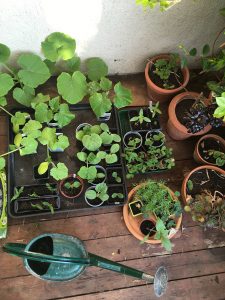Nothing about this year is making me want to start moving anything tender out of the greenhouse and into the open air. Normally around this time I would be starting to think about planting out – a tiny bit earlier than elsewhere but generally here in Bristol in the south west we have a mild climate, late frosts are rare and we can get away with it. About now, as well as planting up my tomatoes indoors in the greenhouse into their final pots, I would normally be looking at the possibility of planting a couple of cucumbers and a winter squash or two, but for now the temperatures are so low that I can’t bring myself to. Will there be another frost? Who knows. But nothing about this spring is even attempting to lull me into the sense of security that normally makes me feel like pushing at these boundaries, and so indoors they stay.

But they will need to go out sooner or later, and it might be a good idea to start acclimatising some of your plants, albeit with a few belts and braces to make sure they don’t get a shock. If you have any plants in the greenhouse that you are going to eventually plant outdoors, ‘hardening off’ is sensible and can be done really gradually if the weather stays cool. Start by moving them outdoors for a few hours during the daytime and back in at night. Next leave them out all day, and then back in at night, and finally move them out all day and night, but leave them in a sheltered spot and cover them with horticultural fleece. When you first plant them out you might consider wrapping them in horticultural fleece or covering them with a cloche for a week or so, particularly if the weather continues to be cold, but even if it doesn’t, as even in warm spring weather temperatures can plummet at night.
In the greenhouse though it is a different matter, because it is absolutely high time to plant up the tomatoes and the other heat-living plants that are going to be living here all summer long. The basic rule with tomatoes is that they are going to get much, much bigger than you think they are when you are planting them out. You want to provide them with substantial containers in a greenhouse situation, and sturdy supports, otherwise they will be continually drying out and toppling over. A length of bamboo is ok, but it is far better to make a tall tripod of bamboo canes, which will hold up better. Lengths of wood can work much better. Any support you use need to be sunk deep down into the pot, ideally touching the bottom of it.
When filling your pots use a peat-free multipurpose compost and add some water-retaining granules, just as you might when planting up a hanging basket. Continuity of moisture at the roots is what you are looking to provide, because plants that dry out and are soaked can be subject to problems such as skin splitting – as the skin hardens during dry spells and then the fruit subsequently expands after watering – and blossom end rot. Put other measures in place to aid easy watering too. Sinking an upside down cut off plastic bottle into the compost near to the roots will prevent water from just rolling off the top of the compost, and will get it right down to the roots. Saucers underneath pots create a well of moisture for the plant to draw on, and make it easier for you to water.


